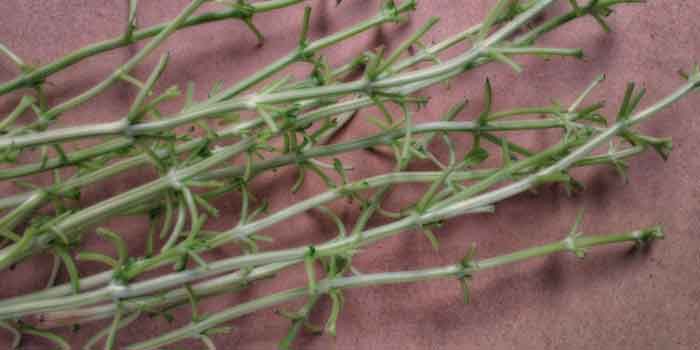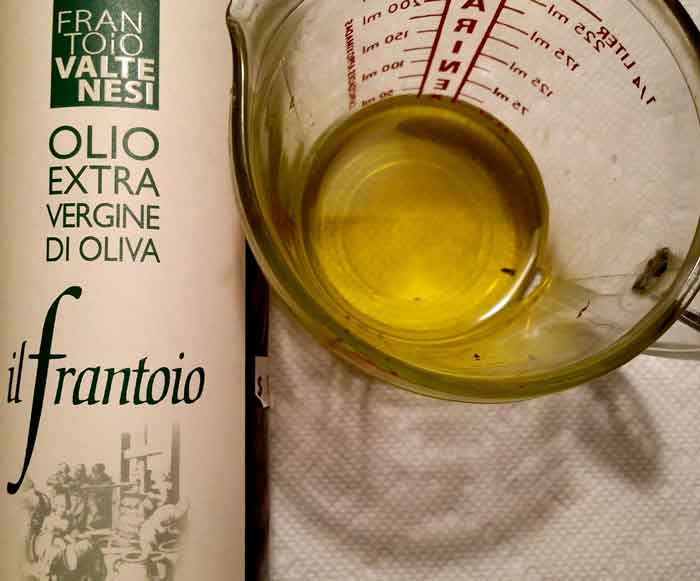The header image shows the first major harvest at Balcony Farms. On Sunday morning, a pleasant few hours were spent cutting stems from a pot of basil and carefully snipping each stem at the point it met the basil leaf. I hi-graded the harvest. Doubtful leaves, or yellowish leaves, were discarded. There were few of these, and they all came from lower on the stem.

Basil Stems after Leaf Removal
The basil leaves were collected in a colander with a top diameter of 11 inches and a depth of 5 inches. Leaf from 14 stems filled the colander to the brim. My first thought was “Wow, this is way more leaf than I was expecting. I will end up with gallons of pesto.” When the leaves were packed down into the measuring cup, there was no more than two cups of leaf.
Harvest – Pesto Ingredients
The sole raison d’être for a balcony covered with basil plants is to convert those plants into jars of delicious pesto. On my walking trips, I shopped for the needed supplies. First, came the pine nuts ( I spent the past hour searching for the receipt. I suspect it dissolved in the last major storm. These things happen). The next key ingredient was garlic. Fresh bulbs were purchased at the Farmer’s Market. Extra Virgin olive oil, and a wedge of Pecorino Romano, came from an Italian specialty foods store on Wellington West. Apart from waiting for the basil plants to reach fragrant perfection, everything was set.

Harvest – Pesto Recipe
The recipe for pesto is simple:
- 2 cups packed fresh basil leaves (One brimming colander, or about 14 stems)
- 1/2 cup freshly grated Romano
- 1/2 cup extra virgin olive oil
- 1/3 cup pine nuts
- 3 garlic cloves, minced
- freshly ground black pepper with salt to taste
The traditional method of making pesto is to combine all of the ingredients using a mortar and pestle. The leaf is ground down until it becomes a thick, coarse paste. Pesto made in the traditional way is very hard work. I did it once, using a smooth bottom mortar. Use of a mortar with a ridged bottom is preferable as the ridges would help crush and tear the leaf. Even easier would be to turn the job over to the kitchen servants. This is the route I took.

Edgar Cusinarto was pressed into service. With the shocking application of electricity, Edgar spun into action. A few moments devoted to bowing and scraping and the pesto was done. The huge amount of leaf reduced to little more than one cup of pesto. This was divided. One portion was frozen for delivery it to one of my doctors. I wanted to gift her as thanks for all of her work on my behalf. The second portion was reserved for tonight. To freeze the pesto, the cheese must be omitted. A pleasant 15 minutes has just been spent grating a quarter cup of Romano. The water is boiling, the pasta is rolling about in saucepan, the kitchen is filled with steam. Dinner is awaited with high expectations.
Harvest – The Repast
The meal was very good and very filling. I eat commercial pesto on a regular basis. My much smaller quantity of homemade appears to dress more pasta than twice the quantity of commercial pesto. In making tonight’s dinner, I used perhaps one third of a cup of pesto.
Checking the label on a jar of commercial pesto discloses the primary ingredient to be sunflower oil. The second listed ingredient is an inferior cheese and this is followed by potato flakes (!!). More cashews are used than pine nuts. The commercial pesto lacks the heavy paste consistency of home made pesto. Commercial pesto is lighter, less viscous, and much more oily. I much prefer home made.
Harvest – Variations
One variation is to substitute walnuts in place of pine nuts. This delivers two benefits. First, there is the beneficial inclusion of walnut oi, an oil that places very high on health benefits. Second, the price of walnuts is roughly one half the cost of pine nuts. If the commercial pesto producers can substitute cashews it seems reasonable to see what difference walnuts may make.
The oil used, while labelled as “extra virgin,” lacks the astringent flavour of true extra virgin olive oil. I remember the first time I bought extra virgin oil. It was in Vancouver over 40 years ago. When I first tasted the oil, I thought it had gone off so different was the flavour compared to regular bottled olive oil. But that astringent flavour is the true taste of the olive. I suspect that a “true” extra virgin oil is outside my budget.
My other thought is to add some lemon juice. This would achieve two things. The lemon juice may add back the astringent flavour imparted by a higher quality olive oil. And second, the addition of lemon juice would help prevent the pesto browning as it oxidizes in the air.
